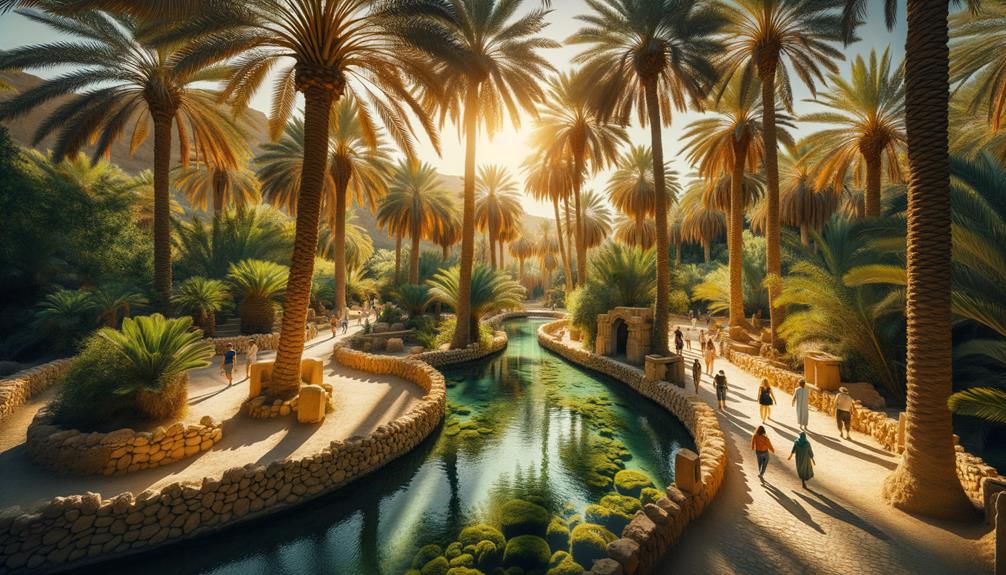As I stepped into the Elche Palm Grove, the sheer scale of the towering palm trees transported me to another era. This ancient grove, with roots dating back to prehistoric times, felt like a living history book. The sophisticated irrigation system, introduced by the Moors, was a testament to the ingenuity and resilience of the people who built it. Wandering through the lush Huerto del Cura garden, I was struck by the intricate balance of nature and human craftsmanship. And just when I thought I'd seen it all, the grand Palacio De Altamira beckoned me with its promise of more stories waiting to be uncovered.
History of Elche Palm Grove
The Elche Palm Grove, a lush oasis in the heart of Spain, has a rich history that dates back to prehistoric times, flourishing during the Muslim period. As I strolled through the largest palm grove in Europe, I was struck by the sheer scale – over 200,000 palm trees, their leaves rustling in the breeze, forming endless rows that seem to touch the sky.
The ingenious irrigation system, brought from the Middle East, showcases the brilliance of Al-Andalus culture. This system ensures each tree receives just the right amount of water, sustaining the grove's lushness in a region where water is precious. The intricate network of canals and ditches, still in use today, speaks to the ancient knowledge that nurtured this oasis.
Walking through Municipal Park and the Huerto del Cura garden, I felt connected to centuries of history. The palms stood as silent witnesses, bearing testament to the passage of time. This grove isn't just a collection of trees; it's a living, breathing testament to human ingenuity and the harmonious relationship between humans and nature. It's an evocative journey into the past that resonates deeply with those seeking freedom and connection.
Cultural Significance
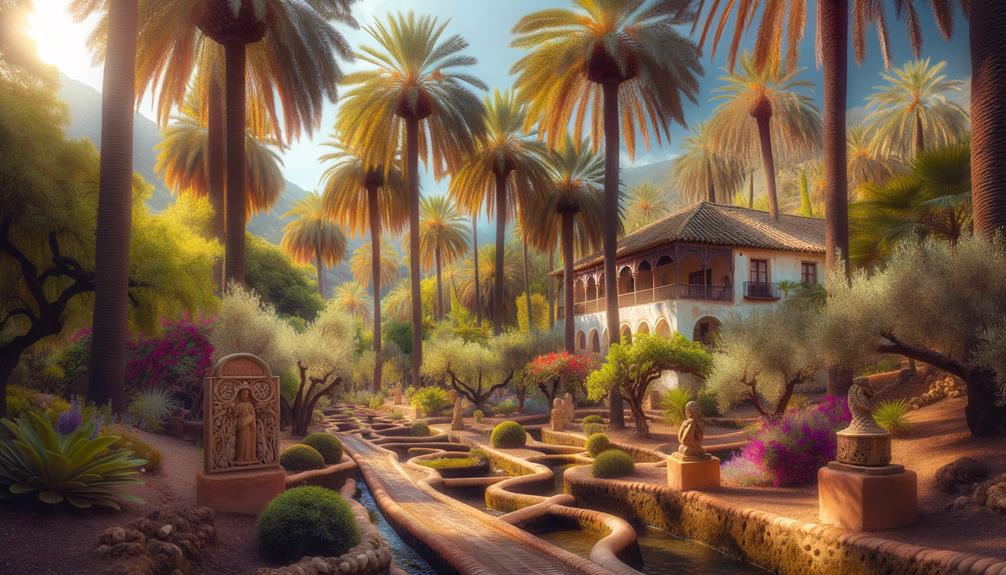
Walking through the Elche Palm Grove, I felt a deep connection to the rich history that anchors this extraordinary landscape. The Palmeral de Elche is more than just a collection of palm trees – it's a living testament to the cultural exchange between East and West. The advanced watering system, a marvel of ancient agricultural practices, is a clear influence of Al-Andalus culture.
As I strolled through the serene Huerto del Cura garden, the cultural significance of this UNESCO World Heritage site became even more apparent. The garden's meticulous layout and lush vegetation are not only visually stunning but also steeped in historical stories. Each palm tree seemed to whisper tales of the past, connecting me to the generations of gardeners and visionaries who shaped this oasis.
The El Palmeral Museum provided a deeper understanding of the heritage and history of the palm grove. By following the Route of El Palmeral, I was able to experience the traditional palm groves up close, appreciating the cultural legacy that has been preserved for centuries. This journey through the Palmeral de Elche is a vivid reminder of human ingenuity and cultural exchange.
Exploring Palacio De Altamira
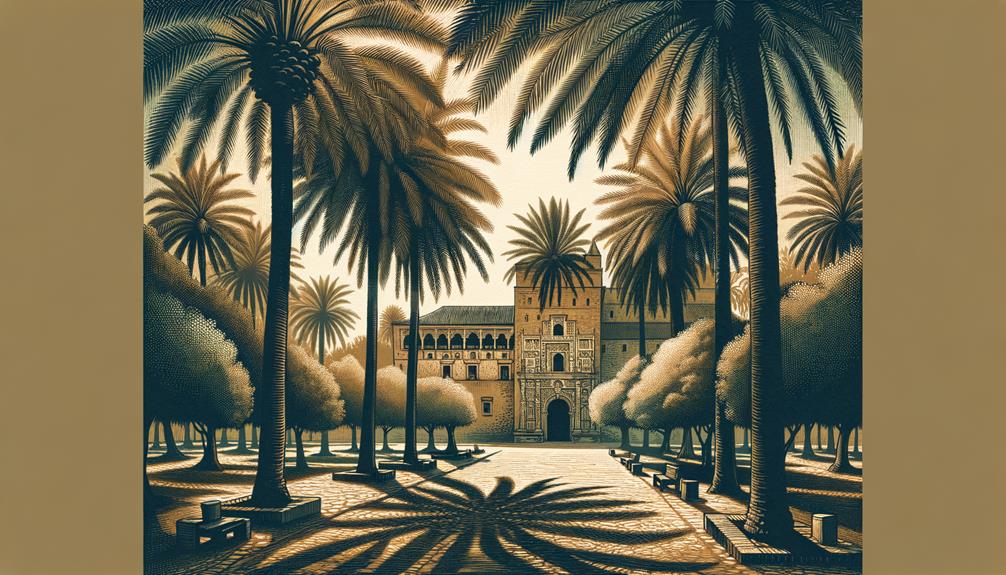
Just a short stroll from the Elche Palm Grove, I arrived at the modern marvel that is Palacio de Altamira, where sleek design meets rich cultural heritage. This museum, situated mere steps from the lush palms, offers an extraordinary experience that seamlessly blends the old with the new.
As I walked through its corridors, I felt an instant connection to Elche's vibrant past. The museum's innovative design brings history to life, making it feel tangible and real. Palacio de Altamira is more than just a cultural attraction – it's an immersive experience that deepens your understanding of Elche's legacy.
| Location | Distance from Palm Grove | Type |
|---|---|---|
| Elche Palm Grove | 0.3 km | Historical Site |
| Palacio de Altamira | 0.3 km | Modern Museum |
| Basilica of Santa María | 0.5 km | Religious Site |
The contrast between contemporary architecture and centuries-old relics is striking. As I explored the exhibition halls, each display seemed to share stories of bygone eras. The museum's layout encourages visitors to roam freely, making it a must-visit cultural attraction for anyone eager to delve into Elche's multifaceted history.
Palacio de Altamira's thoughtful design enhances the display of artifacts, making history feel alive and engaging. The museum is an experience that broadens your understanding of Elche's cultural significance.
Basilica of Santa María
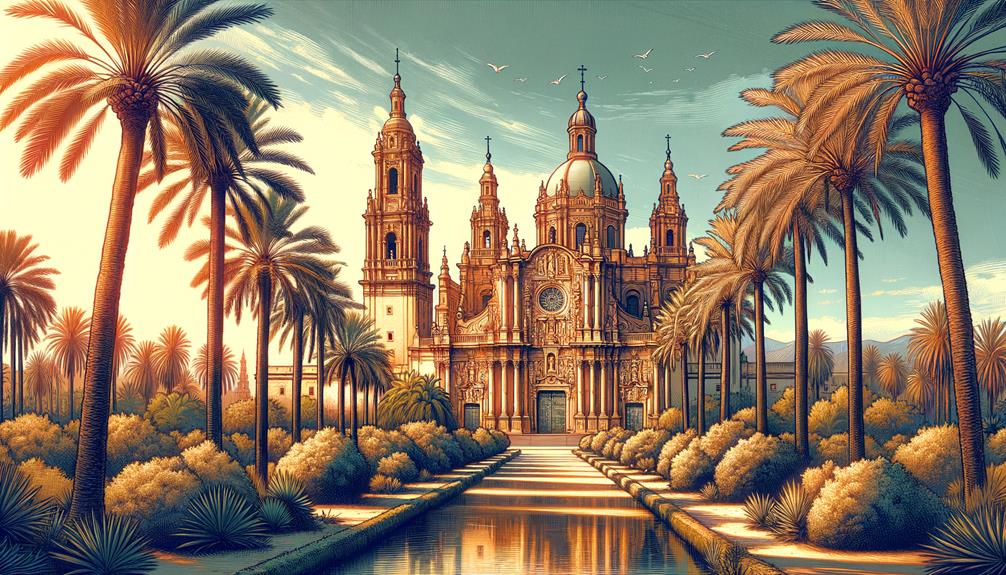
As I walked into the Basilica of Santa María, I was struck by the grandeur of its baroque architecture. This iconic venue is home to the mesmerizing Misterio de Elche, a theatrical performance that brings centuries-old religious traditions to life. The rich cultural and spiritual heritage here is palpable, making it a memorable highlight of my visit to Elche.
Cultural and Religious Performances
The Basilica of Santa María in Elche offers a fascinating glimpse into the region's rich cultural and religious heritage through its captivating performances and historic atmosphere. As I entered, I felt the weight of history and reverence that permeates the air.
One of the most iconic cultural performances held here is the Misterio de Elche, a medieval mystery play that has been performed annually for centuries. Set against the stunning backdrop of the Basilica's architecture, this sacred drama transports the audience to another era, blending spirituality and artistry in a unique way. As a UNESCO Masterpiece of the Oral and Intangible Heritage of Humanity, the play reflects the deep cultural roots of Elche.
Beyond the Basilica's walls, the nearby Palmeral and Huerto del Cura garden enrich the cultural experience. The lush greenery of the Palmeral provides a serene contrast to the solemnity of the Basilica, while the Huerto del Cura garden offers a peaceful retreat to reflect on the performances. Together, these elements create a rich tapestry of cultural and religious experiences that make a visit to Elche both enlightening and unforgettable.
Historical and Architectural Significance
The Basilica of Santa María stands as a testament to Elche's rich history and architectural prowess, combining Gothic and Baroque elements in a breathtaking structure. As I stepped inside, I felt an instant sense of reverence. The intricate designs and towering spires reflect centuries of craftsmanship and devotion, telling a story with every stone and archway.
Nestled among the famous palm groves, the Basilica of Santa María is more than just a place of worship – it's a cornerstone of Elche's cultural identity. Its connection to the Misterio de Elche mystery play adds depth and significance, making it a must-visit destination for anyone exploring the city's heritage.
The basilica's architecture is undeniably stunning. The blend of Gothic and Baroque styles creates a visual feast that inspires and captivates. Standing in the Huerto del Cura, gazing at the basilica's majestic silhouette framed by lush palm trees, I felt a deep appreciation for this timeless masterpiece. It's a poignant reminder of Elche's enduring legacy.
El Huerto Del Cura Garden
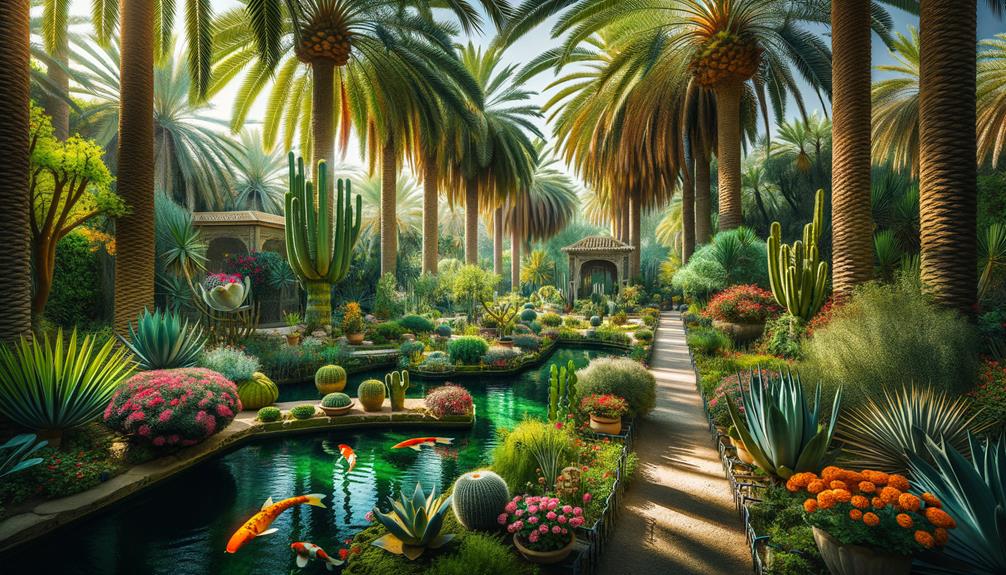
Wandering through El Huerto Del Cura Garden, I felt like I'd stumbled upon a serene oasis within the historic Elche Palm Grove. This National Artistic Garden, part of the UNESCO World Heritage site, celebrates the beauty and cultural significance of Elche's palms.
Located just 0.9 km from the main palm grove area, El Huerto Del Cura Garden offers a unique blend of nature and artistry. Every corner of the garden features carefully curated plant species, from towering palms to exotic flowers, creating a vibrant tapestry of color and texture. As I strolled along the pathways, I marveled at the meticulous design that fosters both tranquility and inspiration.
The garden's atmosphere invites visitors to slow down and absorb the peaceful ambiance. It's an ideal spot for leisurely walks, where you can lose yourself in the lush greenery. Whether you're capturing the beauty through photography or enjoying a quiet picnic, El Huerto Del Cura Garden provides a liberating escape from daily life.
Route Details and Landmarks

Here's the rewritten text:
Starting at the Huerto de San Plácido, home to the Palm Grove Museum, I strolled through a rich tapestry of history and nature. Each landmark, from the serene Huerto del Cura garden to the bustling streets like Curtidors, offered a unique glimpse into Elche's cultural heritage. As I made my way through the intersections, such as Hort del Sol and Camí de Les Almàseres, I encountered diverse landscapes that kept me engaged throughout the journey.
Key Route Highlights
Ever wondered how a stroll through the historic Elche Palm Grove seamlessly blends natural beauty with rich cultural heritage? Starting at Huerto de San Plácido, home to the Palm Grove Museum, I found myself immediately immersed in lush greenery. The gentle flow of the Acequia Mayor del Pantano water channel guided my path.
Midway, the Huerto del Cura garden offered a peaceful oasis with unique palm species and serene landscapes. This living museum felt like a harmonious blend of nature and history. As I pedaled along the bike path, I caught glimpses of the traditional Huertos de Rogeta and Tia Casimira, their timeless beauty whispering stories of the past.
| Landmark | Highlight |
|---|---|
| Huerto de San Plácido | Start and finish point, Palm Grove Museum |
| Acequia Mayor | Historical irrigation channel |
| Huerto del Cura | Unique palm species, serene landscapes |
| Traditional Huertos | Rogeta and Tia Casimira, cultural heritage |
As I continued, the Salesian College stood as a testament to the educational heritage nestled within the grove. Approaching the final stretch, El Jardín de Porta de la Morera felt like a grand finale, leading me towards the Congress Centre. This route, a blend of cultural gems and nature, felt like the essence of freedom, mirroring the best beaches in its pure, unspoiled beauty.
Notable Palm Grove Intersections
Exploring the Elche Palm Grove's intersections, I was struck by how each turn revealed a unique blend of history and nature. My journey began at Huerto de San Plácido, home to the Palm Grove Museum, which set the stage with a rich historical context. As I wandered along, the route led me past Hort de Dins and Camí de Les Almàsseres, each intersection offering a distinct glimpse into the grove's character.
One of the most enchanting landmarks was Huerto del Cura, a lush sanctuary where towering palms seemed to touch the sky. Nearby, the Salesian College and Hort dels Pontos added layers of cultural significance to the walk, blending educational heritage with natural beauty.
Curtidors street stood out, showcasing preserved groves like Casimira, Pastoret, Mareta, Borreguet, and Monjo. Each grove, with its distinct personality, told its own story. The Hort de la Tía Casimira and Hort de Pastoret featured outdoor exercise facilities, inviting a blend of recreation and relaxation. Meanwhile, Camí de Felip offered a serene escape, surrounded by birdlife that brought the grove to life with their songs.
Visitor Experience and Tips
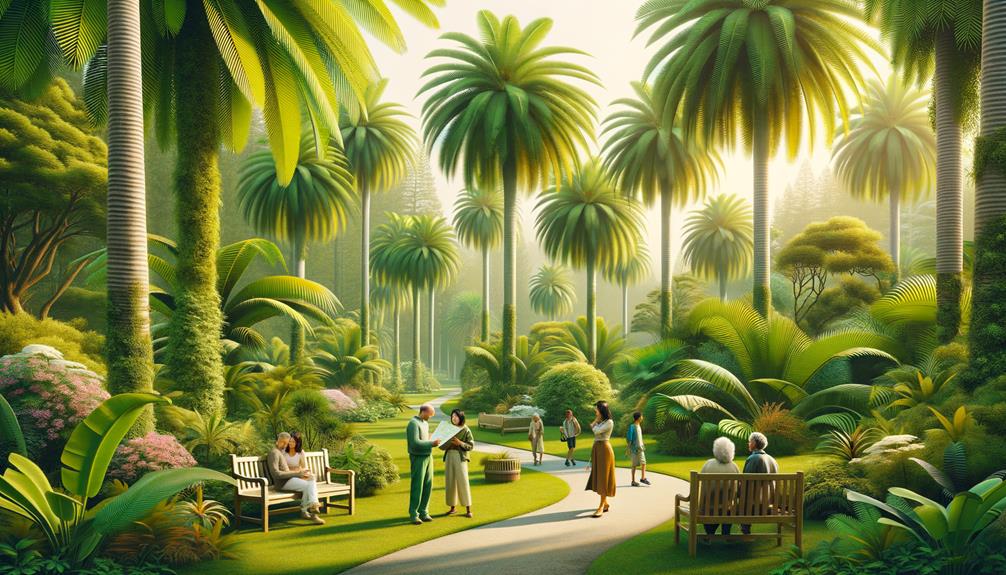
Wandering through the Elche Palm Grove, I felt a deep sense of calm, as the towering palms seemed to whisper stories of centuries past. This UNESCO World Heritage site in the city of Elche offers a serene escape into a world where history and nature intertwine. One of the highlights of my visit was the Huerto del Cura garden, a lush oasis within the grove that features beautifully arranged plantings, peaceful water features, and a stunning array of cacti. It's a nature lover's paradise and a haven for those seeking solace.
As I explored the vast expanse of the palm grove, I joined a guided tour that helped me understand Elche's deep connection to palm cultivation. The guides shared fascinating insights about the grove's historical significance and its importance to the local economy. Walking under the shade of over 200,000 palm trees, I couldn't help but appreciate the beauty and cultural heritage that this place embodies.
For those planning a visit, I recommend wearing comfortable shoes, bringing enough water, and bringing a camera to capture the grove's beauty. Take your time – let the gentle sway of the palms guide your journey through history.

